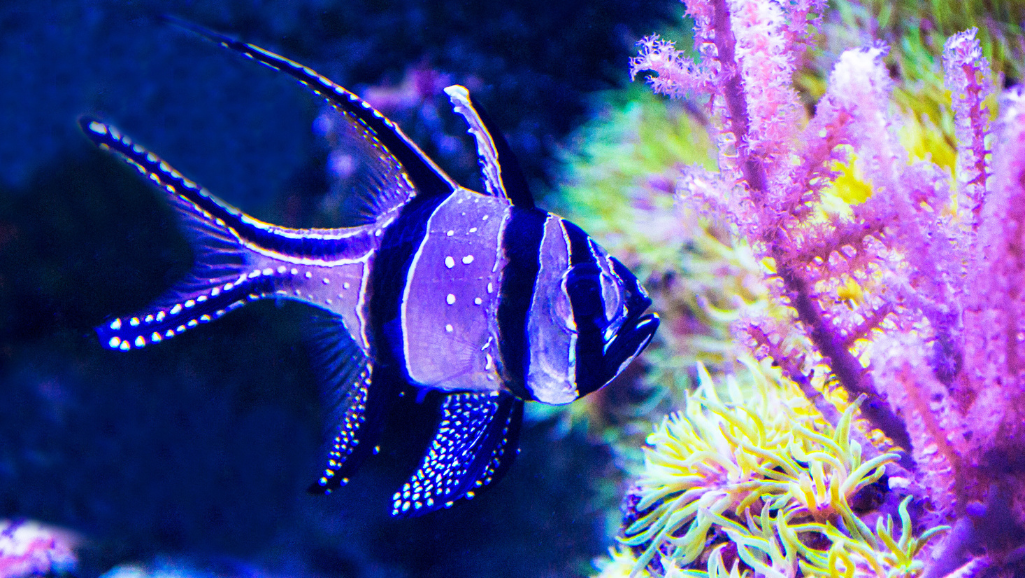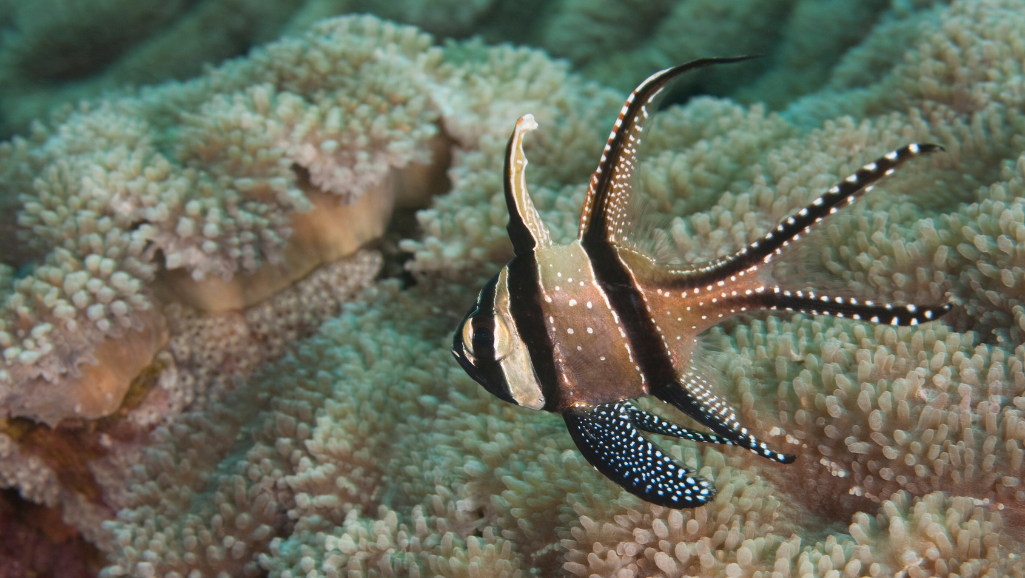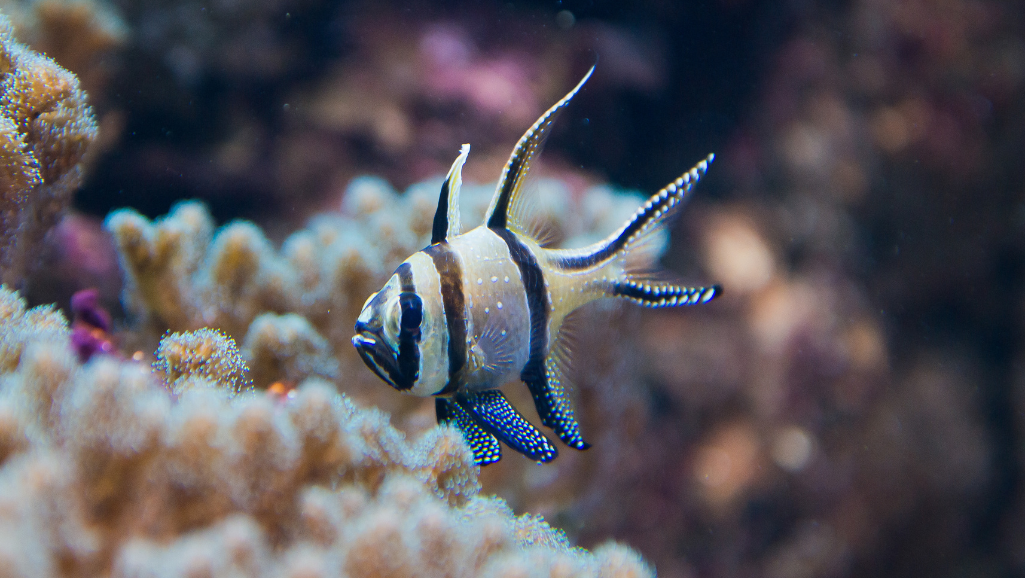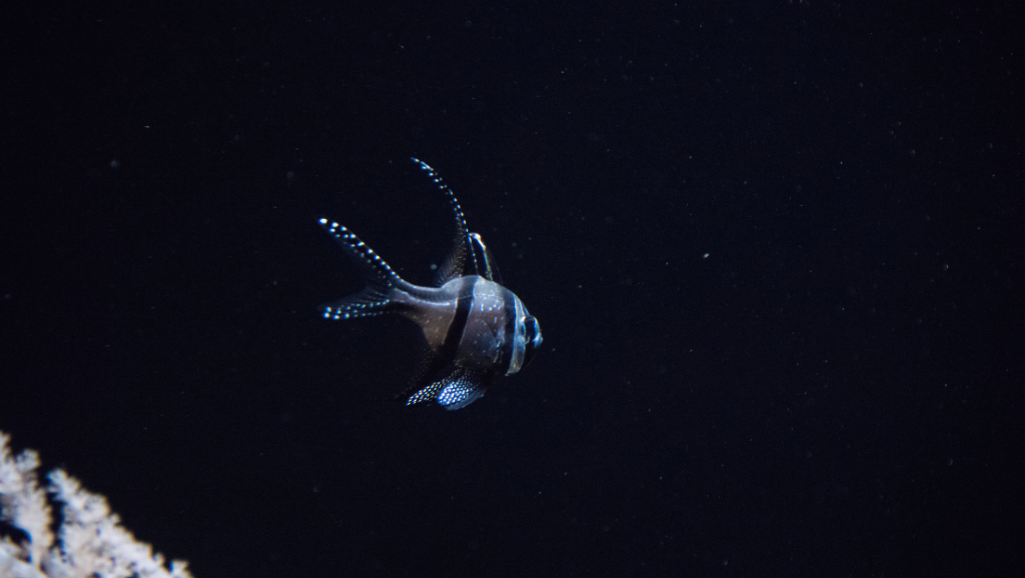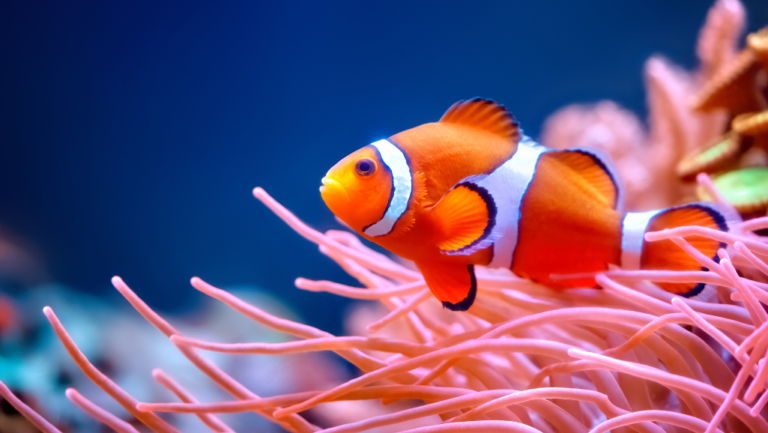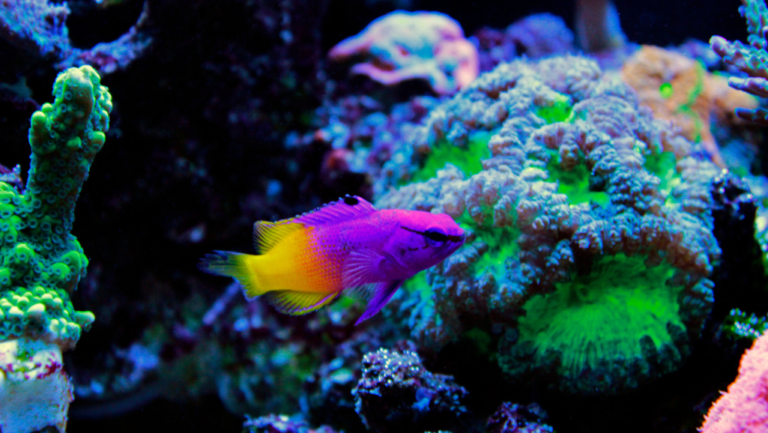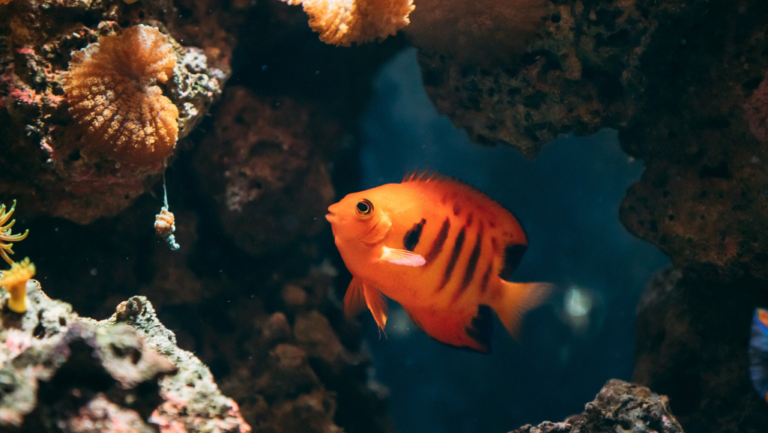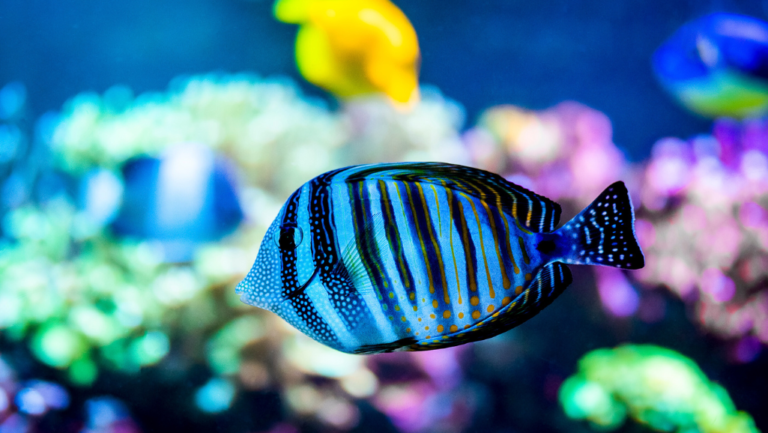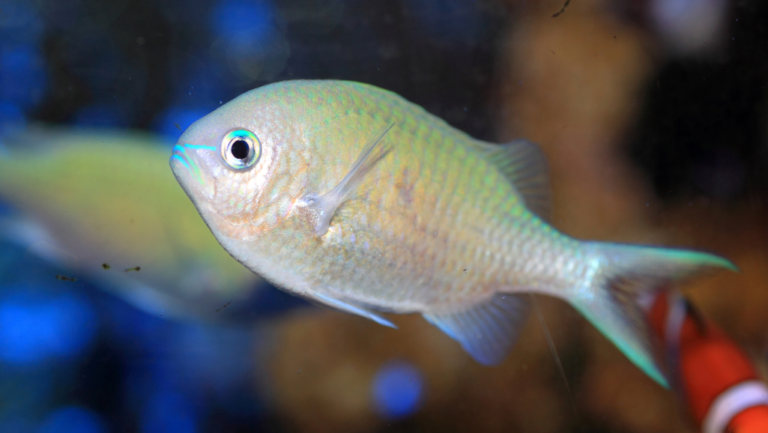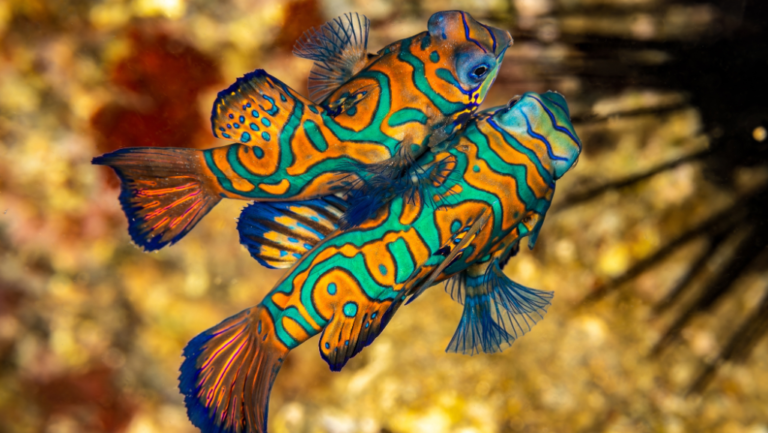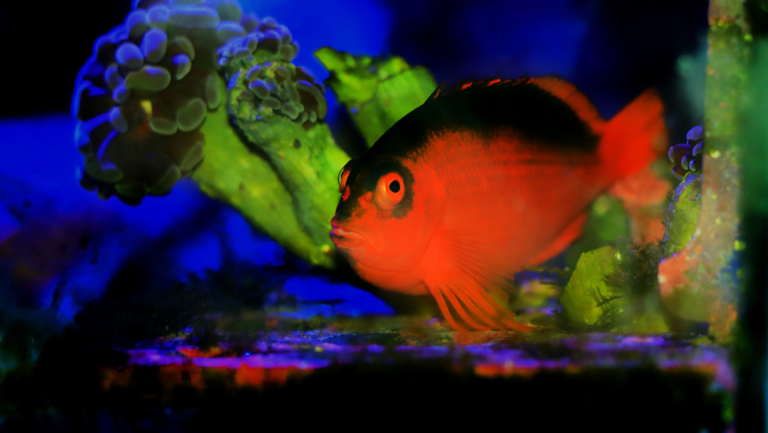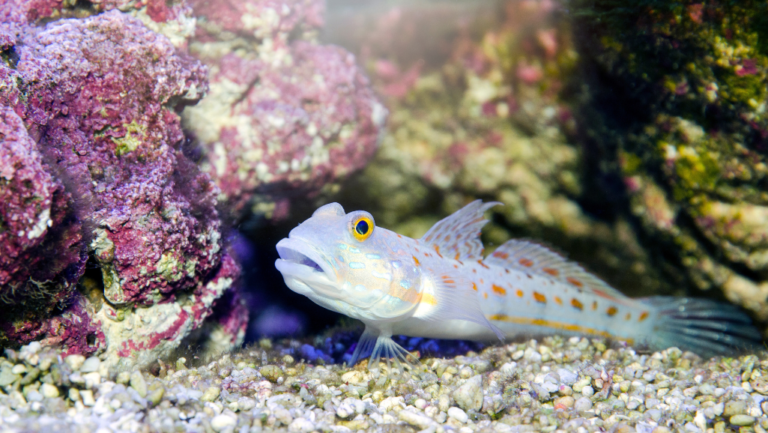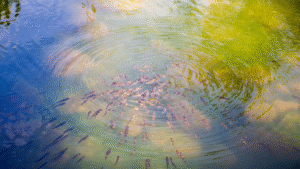The marine aquarium is all about the fish. The Banggai Cardinalfish, or Pterapogon kauderni, is a standout. It’s loved for its beautiful stripes and calm nature. Keeping a Banggai Cardinalfish is a big interest for many.
These fish come from Indonesia’s Banggai Archipelago. In aquariums, they need a special setup. Rocks and coral look good and help them feel at home.
They’re easy to care for, making them popular. They bring a peaceful and interesting look to aquariums. It’s a chance to see Pterapogon kauderni up close.
Key Takeaways
- Knowing how to care for Banggai Cardinalfish is key for a healthy tank.
- A good Banggai Cardinalfish habitat with steady water is important.
- Pterapogon kauderni makes saltwater tanks beautiful and calm.
- It’s vital to breed them responsibly because they’re endangered.
- Creating a natural environment helps them thrive in captivity.
- Choosing the right tank mates and food is part of good care.
- Buying from trusted sellers helps support sustainable practices.
Introduction to Banggai Cardinalfish
Explore the magical world of the Pterapogon kauderni, also known as the Banggai Cardinalfish. This saltwater fish is from Indonesia’s Banggai Archipelago. It’s loved by many for its unique look and interesting ways of acting.
Overview of the Species
The Banggai Cardinalfish lives in the coral reefs and seagrass beds of its home, a small area of about 30 km². It’s known for being tough and having few babies. This makes it important for conservation efforts, like those by Rising Tide Conservation. They suggest buying aquacultured fish to help protect wild ones.
Natural Habitat
The Banggai Cardinalfish loves coral and seagrass homes. They hide in anemones and urchins for safety. They prefer depths under 6 meters and use rocks to hide from predators and strong currents.
This shows how they’ve adapted to their small home. Their survival depends on keeping their habitat healthy.
Popularity in Aquariums
The Pterapogon kauderni is a favorite in aquariums because of its beautiful silver body with black bars and white spots. It’s calm and can live with other sea creatures. This makes Banggai Cardinalfish for sale popular in the fish trade.
But, it’s important to buy aquacultured fish to help protect wild ones. Companies like Quality Marine and Petco are working to sell more aquacultured Banggai cardinalfish. This is a step towards a more sustainable fish trade.
Physical Characteristics of Banggai Cardinalfish
The Banggai Cardinalfish, known as Pterapogon kauderni, is a favorite among aquarium fans. It’s small but vibrant, with unique features that make it stand out. These traits set it apart from other marine fish.
Distinctive Markings
The Banggai Cardinalfish’s most striking feature is its bold colors and patterns. Its body has vertical black bands against a silvery-white background. These bands are dotted with white, making it look even more ornate.
Its fins also have bright white margins. This adds to their beauty when seen under aquarium lights.
Size and Lifespan
The Banggai Cardinalfish grows up to 8 cm (about 3 inches) long when fully grown. They fit well in smaller marine aquariums. Despite their small size, they can live a long time with proper care.
In a well-kept aquarium, they can live up to five years. But, they usually live for 2.5 to 3 years. Their small size and long life make them great for home aquariums.
Knowing about the Banggai Cardinalfish’s physical traits helps us appreciate their beauty. It also helps us care for them better. By understanding their size and lifespan needs, we can create a healthy home for them.
Ideal Habitat for Banggai Cardinalfish
To create a great home for Banggai Cardinalfish, you need to focus on tank size, water quality, and keeping the temperature and pH right. These fish are endangered, so it’s key to build a safe and healthy space for them to live and thrive.
Tank Requirements
Start with a tank that’s at least 30 gallons for one or two fish. This size lets them move around and behave naturally, which is good for their health. Their tank should look like a reef, with lots of hiding spots and places for them to breed.
Use live rocks and coral to make the tank look like their home. This helps them feel comfortable and secure.
Water Parameters
- Temperature: Keep the water between 73-84 degrees Fahrenheit to match their tropical home.
- pH Levels: The pH should be between 8.1 to 8.4, as they do best in slightly alkaline water.
- Salinity: Keep the salinity around 35 g/L for their health and well-being.
- Ammonia and Nitrites: Make sure these are at 0 ppm to keep the water safe and healthy.
Temperature and pH Levels
Keeping the temperature and pH stable is very important for Banggai Cardinalfish. Changes can stress them out, making them sick. Use good heaters and filters to keep the water just right.
This helps them stay healthy and happy. It’s also important when choosing tankmates to make sure everyone gets along.
Following these tips will help you create a great home for your Banggai Cardinalfish. It’s all about keeping them safe and happy in your aquarium.
Feeding Banggai Cardinalfish
Knowing what Banggai Cardinalfish eat is key to keeping them healthy in your tank. These fish love meaty foods and need a varied diet to thrive.
Dietary Needs
Banggai Cardinalfish need foods that match what they eat in the wild. They love small crustaceans and zooplankton. In your tank, give them protein-rich foods to keep them healthy.
- Vitamin-enriched Brine shrimp and Mysis shrimp are great for their nutrition.
- Adding krill, chopped prawns, and squid can make their diet more interesting.
Recommended Foods
Feed them a mix of live, frozen, and pellet foods. Live foods like brine shrimp help them get used to tank life. Then, slowly introduce frozen and pellet foods.
- Start with frozen foods slowly to avoid stressing them.
- Adding pellets to their favorite frozen foods helps them accept a varied diet.
Feeding Frequency
Feeding them often is important for their health. Feed them small amounts several times a day. This is like their natural feeding schedule in the wild.
- Adults do well with two to three meals a day.
- Watch how they react to food to see if you’re feeding them right.
For more tips on caring for Banggai Cardinalfish, check out this guide. It offers detailed advice on their needs and how to keep your tank lively and healthy.
Social Behavior and Compatibility
It’s important to know how Banggai Cardinalfish (Pterapogon kauderni) get along in a community tank. They are mostly peaceful but need the right tank mates and setup to do well.
Tank Mates
Banggai Cardinalfish get along with many calm fish. Good friends for them include Lawnmower Blennies, Royal Grammas, and Ocellaris Clownfish. These fish don’t fight over space or food. But, they might fight with other Banggai Cardinalfish, so a big tank is best.
A tank of at least 29 gallons is a good size. Bigger tanks give more room for all fish to live without fighting.
Territorial Behavior
Even though Banggai Cardinalfish are not usually mean, males can get territorial. This happens when they don’t have enough room. Small tanks can make them stressed and mean, which is bad for everyone.
Having a big tank with lots of hiding spots helps. It makes it less likely for them to fight with each other.
Breeding Behavior
Breeding Banggai Cardinalfish is special. Males take care of the eggs in their mouth. This is a big responsibility and needs a calm tank.
Other fish might disturb them during this time. Watching how fish interact is key to keeping the breeding male and the fry safe.
To breed Banggai Cardinalfish, you need to know about their needs. They need the right water and space for breeding to be successful.
Health Issues and Care
It’s important to know about health issues and care for Banggai Cardinalfish. They are delicate, so keeping them healthy is a big responsibility. By focusing on Pterapogon kauderni health, you can create the best living conditions for them.
Common Diseases
Banggai Cardinalfish can get sick with diseases like fin rot and white spot disease. It’s key to spot these problems early. Look for signs like odd swimming, spots, or thinning near the spine and tail.
Prevention Strategies
- Keeping the water clean is vital. Change it regularly but not too much to avoid stressing the fish.
- Check the water’s salinity, pH, and temperature often. This helps keep the environment stable for Banggai Cardinalfish care.
- Feed them a mix of Cyclop-eeze, brine shrimp, and Mysis shrimp. Adding live food now and then is good too.
Treatment Options
If your fish gets sick, act fast. The treatment depends on the disease. It might include quarantining the fish, medicated baths, or adjusting the tank.
Watching over Banggai Cardinalfish closely is key. Knowing the signs of disease and taking steps to prevent it helps. With the right care, these beautiful fish can thrive.
Breeding Banggai Cardinalfish in Captivity
The process of breeding Banggai Cardinalfish in captivity is complex. It requires a deep understanding of their unique breeding behaviors. By breeding these fish, enthusiasts can help protect a species that is vulnerable in the wild.
Breeding Process
To start, you need to identify and pair males and females ready to spawn. Males show remarkable mouthbrooding behavior. They incubate eggs in their mouths for about 20 days, keeping them safe and aerated.
During this time, the males don’t eat, relying on their stored energy. This behavior protects the eggs from predators and environmental changes. It helps increase the chances of Pterapogon kauderni fry survival.
Fry Care
After the male releases the fry, they need to be moved to a separate tank. This tank should have a sponge filter and good water quality. The fry’s first diet should include microalgae and newly hatched brine shrimp.
This diet is essential for their early growth and development. For more information on caring for these fry, check out detailed guides on fish care. Learn more about marine life and how to keep your aquarium vibrant and healthy.
Raising Juveniles
Monitoring the growth of juveniles is critical. They need timely feeding and regular water changes to stay healthy. A 10-gallon tank is a good size for their grow-out environment.
In this controlled setting, young Banggai Cardinalfish can thrive. They gradually adapt to conditions that mimic their natural habitat. Successful care of juveniles can lead to healthy adults that can reproduce.
Persistence and patience are essential in breeding Banggai Cardinalfish. By creating an environment that closely resembles their natural habitat, breeding these fish can be rewarding. It also helps in the conservation of this fascinating species.
Conclusion: Keeping Banggai Cardinalfish
Keeping Banggai Cardinalfish healthy requires careful attention. They need a big tank, stable water, and the right food. It’s also important to watch their water and choose the right tankmates.
Summary of Care Tips
These fish are best kept alone or in pairs. This helps avoid stress and fights. They eat live food often, and males stop eating when they breed.
Their babies can eat brine shrimp right away. This helps them survive better. Taking good care of them is key to their health.
The Importance of Conservation
Conserving Banggai Cardinalfish is very important. They are rare and need our help. Fishing methods harm their homes and the reefs.
Buying captive-bred fish helps a lot. It supports sustainable fishing and protects the reefs. We all need to work together to save these fish and their homes.

